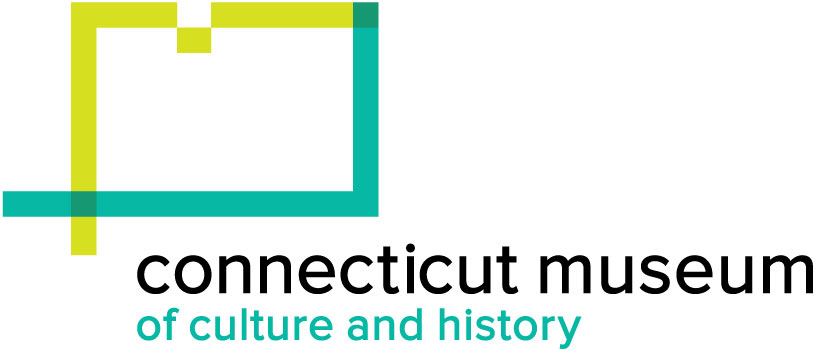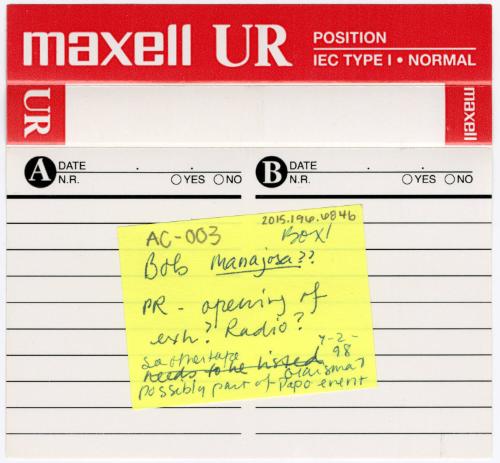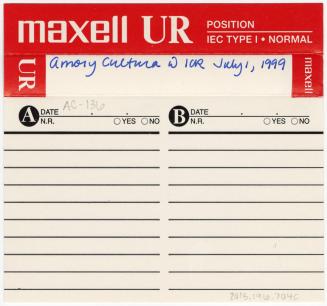Puerto Rican Bomba Music
Date1998
Mediumreformatted digital file from audio cassette
DimensionsDuration: 12 Minutes, 9 Seconds
ClassificationsInformation Artifacts
Credit LineConnecticut Cultural Heritage Arts Program collections
CopyrightIn Copyright
Object number2015.196.684a-c
DescriptionAudio cassette tape recording of Puerto Rican bomba music. The origin and artists are not identified. The tape was collected by CCHAP to use at the opening of the "Mano a Mano: Puerto Rican Traditional Arts From Island To City" exhibition presented in 1998 at the Institute for Community Research Gallery.
NotesSubject Note: The Puerto Rican traditional dance form known as bomba developed on the sugar cane plantations throughout the coastal areas of the island, arising as the musical expressions of enslaved Africans brought to work there from the 17th century. Connections with other colonized Africans and Caribbean groups from Haiti, Cuba, and Santo Domingo created a rich variety of percussion-driven rhythms in bomba, along with songs and dances that told stories, related histories and social values, and sometimes conveyed messages of rebellion. Traditional instruments include barrel drums, maracas, and rhythm sticks. Songs and dances are extemporaneous and creative in conversation with the drum rhythms in call and response patterns. Bomba has been constant in the musical landscape of Puerto Rico among traditional communities, accompanying community gatherings and festivals, as well as public performances.Subject Note: "Mano a Mano: Puerto Rican Traditional Arts from Island to City," began with the July 1, 1999, opening at the ICR gallery of an exhibition of fourteen craft forms practiced in Puerto Rico. Later in the summer, five master traditional artists traveled from Puerto Rico to offer week-long workshops in their craft forms to the public. After the workshops ended, participants who wanted to continue working with their crafts were mentored by the local artists on the project team.
This project was funded by the Lila Wallace Readers Digest Fund Community Folklife Program, the Roberts Foundation, the Greater Hartford Arts Council, the National Endowment for the Arts, the Connecticut Commission on the Arts, PRIDCO, and the Institute for Community Research.
Members of the project team were Melanio J. González, Pavlova Mezquida (PRIDCO), Glaisma Pérez-Silva, Graciela Quiñones-Rodríguez, Marcelina Sierra, Victor M. Sterling, and Lynne Williamson. Because of the knowledge and time needed to locate and purchase appropriate materials for the five workshops, ICR hired a local Puerto Rican artist, luthier Graciela Quinones Rodriguez, to help coordinate this important aspect as well as recruitment of workshop participants. The project furthered many goals important to the team, including promoting awareness of the contributions of Puerto Rican artists, increasing access within the Puerto Rican community to training in art and entrepreneurial skills, and encouraging relationships across generations. The traditional arts and crafts of Puerto Rico remain vibrant and beloved, both on the island and in the new places where Puerto Rican people have settled. The project celebrated the strong cultural traditions remembered and practiced by so many in Hartford's large Puerto Rican community.
Artistic, social, and cultural practices within Connecticut Puerto Rican communities show a regular and active maintenance of familiar traditions which link urban Puerto Ricans to the island, to which many return for visits. The primary goal of the project was to reinforce these patterns of cultural practice and remembrance. Other goals included: 1. To address the need for more public programming and education in Puerto Rican cultural expressions, both for members of this community and for general audiences; 2. To reinvigorate local Puerto Rican artists by connecting them with master traditional artists from the island who rarely visit the mainland; 3. To help preserve knowledge and practice of Puerto Rican traditional art forms; 4. To provide training and support for local artists who wish to begin or continue to develop an economic base for their artistic productions.
The exhibition drew from the work of master artists and their apprentices who participated in PRIDCO's Traditional Arts Apprenticeship Project. Through the Crafts Development Office of the Puerto Rico Industrial Development Company (PRIDCO), Puerto Rico hosts an island-wide training program in traditional arts. Law 166, first passed in 1986, mandates that five government agencies in Puerto Rico provide services to artisans for their education and for the marketing and promotion of their work. This enlightened policy recognizes that traditional arts contain great cultural value because they express the collective wisdom and the soul of a community of people. Traditional arts also represent a vital link to the past, as they are transmitted from one generation to the next through long-term, informal, one-on-one teaching between a master artist and a student. Learning an artistic form through the process of apprenticeship is a powerful way to pass on cultural knowledge as well as the craft itself; this process also helps to develop relationships across generations.
On display from July-October 1999, the exhibit was designed and installed by the same team which produced ICR's successful Herencia Taína exhibit in 1997. PRIDCO loaned art works from its Traditional Arts Apprenticeship project, featuring 16 important craft traditions practiced in Puerto Rico today. Traditions featured included: Marímbolas/Percussion Instruments; Panderos/Plena Tambourines; Volantines/Kites; Vejigantes/Coconut Masks; Hatillo Mascaras/Wire Net Masks; Artesanía en Lata/Tin Crafts; Talla de Gallos/Carved Roosters; Alfarería Tradicional/Indigenous Pottery; Encuadernación/Bookbinding; Papel Maché/Papier Maché; Talla de Santos/Saint Carvings; Estampas Típicas/Folk Houses; Tejido de Bejuco/Liana Weaving; Tejido de Enea/Cattail Weaving; Mueble de Mundillo/Lace Cushion and Holder; Bolillos/Bobbins; Mundillo/Lace. Based on fieldwork in the Hartford community, ICR and Guakia added examples from local artists working in similar traditions. Based on research done by the PRIDCO's crafts apprenticeship project, Lynne Williamson edited, with PRIDCO and Hartford members of the project team, extensive bilingual labels explaining the art forms. The signage was produced by the Peabody Museum in New Haven.
The community's love for the island and its culture has enhanced Connecticut's cities, especially Hartford, the location of this project's activities. Latinos, primarily Puerto Ricans, make up 35% of Hartford's population. The heart of the community is Park Street, the main thoroughfare in the Puerto Rican neighborhood known as Frog Hollow. Botanicas, bakeries, music clubs, bodegas, and restaurants named for Puerto Rican towns make this a vibrant center of constant activity. Artistic, social, and cultural practices within the community show a regular and active maintenance of beloved traditions which link urban Puerto Ricans to the island, and many return regularly for visits. The primary goal of this project was to reinforce the patterns of cultural practice and remembrance.
Additional materials exist in the CCHAP archive for this project.
Cataloging Note: This project was made possible in part by the Institute of Museum and Library Services MA-245929-OMS-20.
Status
Not on view1999 July 1
Ramón Arroyo
2002 August 7; ca. 1997
Glaisma Pérez Silva
July 1999











